There’s no argument: we’re in a golden age of goaltending in the National Hockey League right now. But it’s a world of haves and have-nots. The gap between the greats in the game and everybody else feels bigger than it ever has before, and teams that don’t have one of the reliable studs are often scrounging for help (or suffering under an unwise contract handed out too soon).
But it’s also a world where the hot hand dominates. Look no further than last season’s Stanley Cup Final. Neither starting goalie in the Final entered the season — or even the postseason for that matter — as their team’s clear number one. The apparent randomness of this position makes the workhorses that much more valuable. But that randomness is also why it is vital to evaluate goaltenders frequently.
At The Hockey Writers, we evaluate goaltenders several times a season, accounting for the instability of the position. Goalies change teams and lose their jobs more frequently than many others. Because of changes like that, we regrade goalies regularly. With that in mind, let’s take a look at the methodology for our evaluation.
Methodology
Because of the fleeting nature of goaltender success, our rankings prioritize numbers from the most recent season, in this case, the recently wrapped-up 2022-23 season. With that said, it would be silly to ignore history or overemphasize a three-month run. Where two goalies are more or less equal, their track record will become a factor in determining a final position. Goalies who have performed at a high level for longer will receive the benefit of the doubt, whereas goalies with great numbers who are relative newcomers may sink a spot or two accordingly. Postseason performances will also be considered, but these small sample sizes should not be over-emphasized.
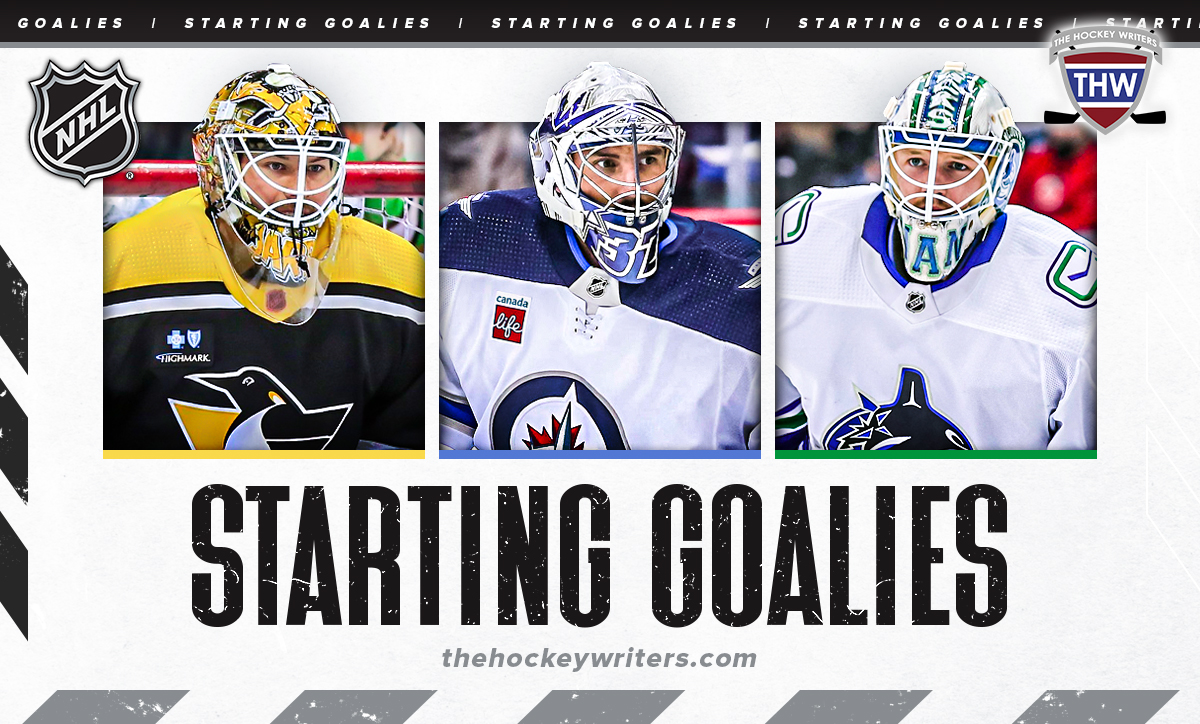
A number of statistics are considered. Two metrics were given primary emphasis: goals saved above average (GSAA) and quality start percentage (QS%). GSAA is a statistical calculation of a goaltender’s performance as compared with his peers. It considers the number of shots he faced and measures it against the league average save percentage on the same number of shots.
QS% measures the percentage of starts in which the goalie’s save percentage (SV%) surpassed the league average SV% for the season. Anything above 60 percent is considered very good, anything below 50 percent is poor, and 53 percent is league average.
Related: Adjusting How We Evaluate and Analyze Goaltenders
In addition to these metrics, we’ll examine SV% and goals-against average (GAA), shutouts (SO), and really bad starts (RBS) where the goalie has a SV% below .850. Judging by those numbers, a composite score was created to represent overall goalie effectiveness. Then, we made adjustments based on experience and track record and settled on a final order.
So, without further ado, here are your goaltender rankings for the middle of the 2023-24 season.
32) Joonas Korpisalo: Ottawa Senators
Previous Rank: 14
Just a glance at the two rankings above quickly proves how fickle the goaltending position can be. Joonas Korpisalo entered the season with a fat new contract from the Ottawa Senators. They believed they’d seen enough in his 11 games and six postseason games with the Los Angeles Kings (after a trade from the Columbus Blue Jackets) to put their faith in him as their goaltender of the future. But less than 30 starts into that contract, with a new general manager and ownership group installed in Ottawa, they might be regretting the decisions of the previous administration already.
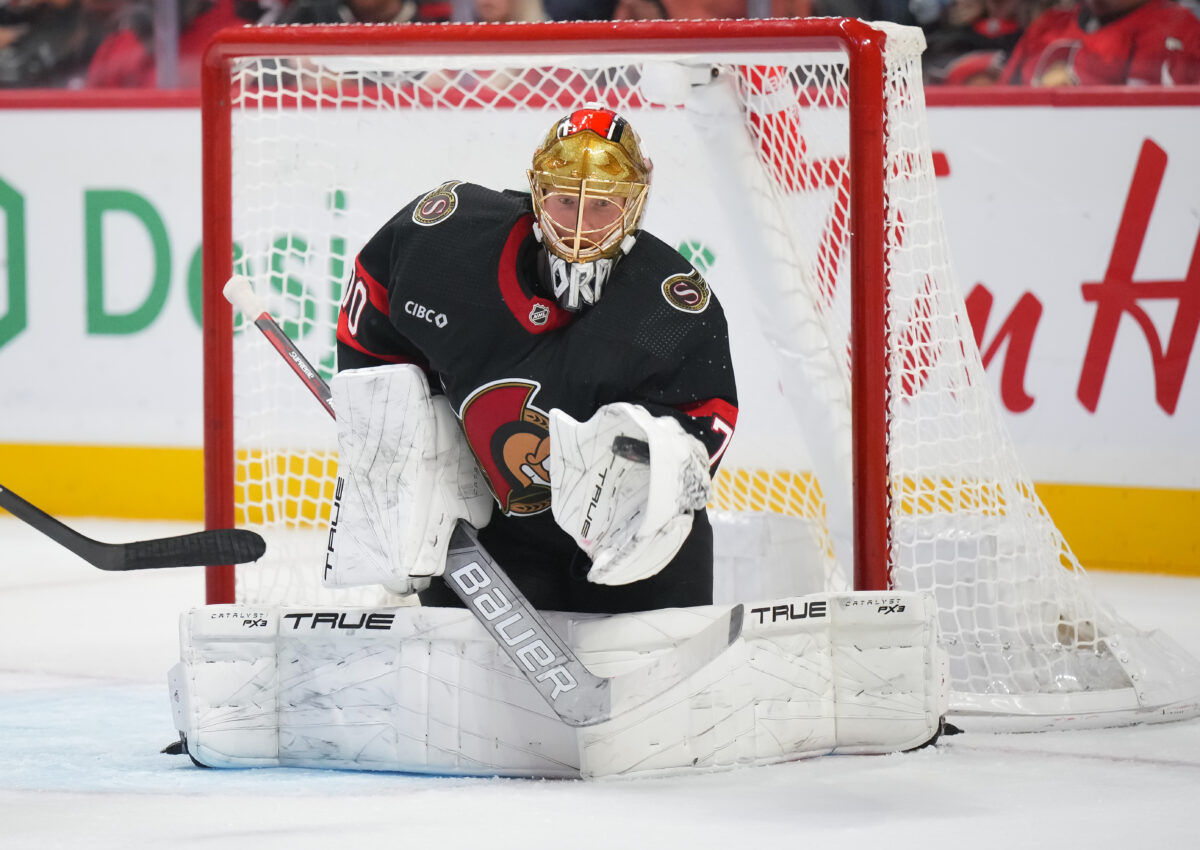
To say it has been a rough start for Korpisalo in Canada’s capital city would be an understatement. He’s played in 28 games, and his record is 9-15-1. This was supposed to be the year Ottawa finally competed for a playoff spot, but Korpisalo is handicapping their ability to do that. His .887 SV% is second-worst amongst goalies on this list, as does his 3.56 GAA. But his minus-13.68 GSAA and .360 QS% rank dead last. It’s a disastrous beginning to his tenure and currently has the Senators ranked last in the Eastern Conference. That, combined with a history of shaky play before his briefly tenure with the Kings, has earned him the last spot on this list.
31) Vítek Vaněček: New Jersey Devils
Previous Rank: 11
Another sinking stone on this list, Vítek Vaněček has been incredibly disappointing with the New Jersey Devils this season. Last postseason, we saw Akira Schmid come from nowhere to lead the Devils to some early success. But Vaněček was believed to be the starter coming into the season after a strong 2022-23 regular season. Unfortunately, he has not built on that so far this season. His .885 SV%, 3.22 GAA, minus-12.3 GSAA, and .417 QS% all rank near the bottom of this list. And he has not build enough of a positive track record in seasons past to offset those negatives. The Devils are one of the most exciting young teams in the NHL, but goaltending will continue to be their Achilles’ heel until they find a new solution. Could it be youngster Nico Daws? Only time will tell, but for now, Vaněček is the starter, and it’s not going well.
30) Mackenzie Blackwood: San Jose Sharks
Previous Rank: Unranked
The Devils once moved on from Mackenzie Blackwood as a potential goalie of the future, and his performance in San Jose suggests that while Vaněček isn’t working out so far, they can’t regret their decision. To be fair, Blackwood has one of the worst jobs in the NHL. It can’t be fun to backstop the San Jose Sharks in the middle of a long and painful rebuild (although at least the weather is good!) But he is hardly turning lemons into lemonade at the moment.
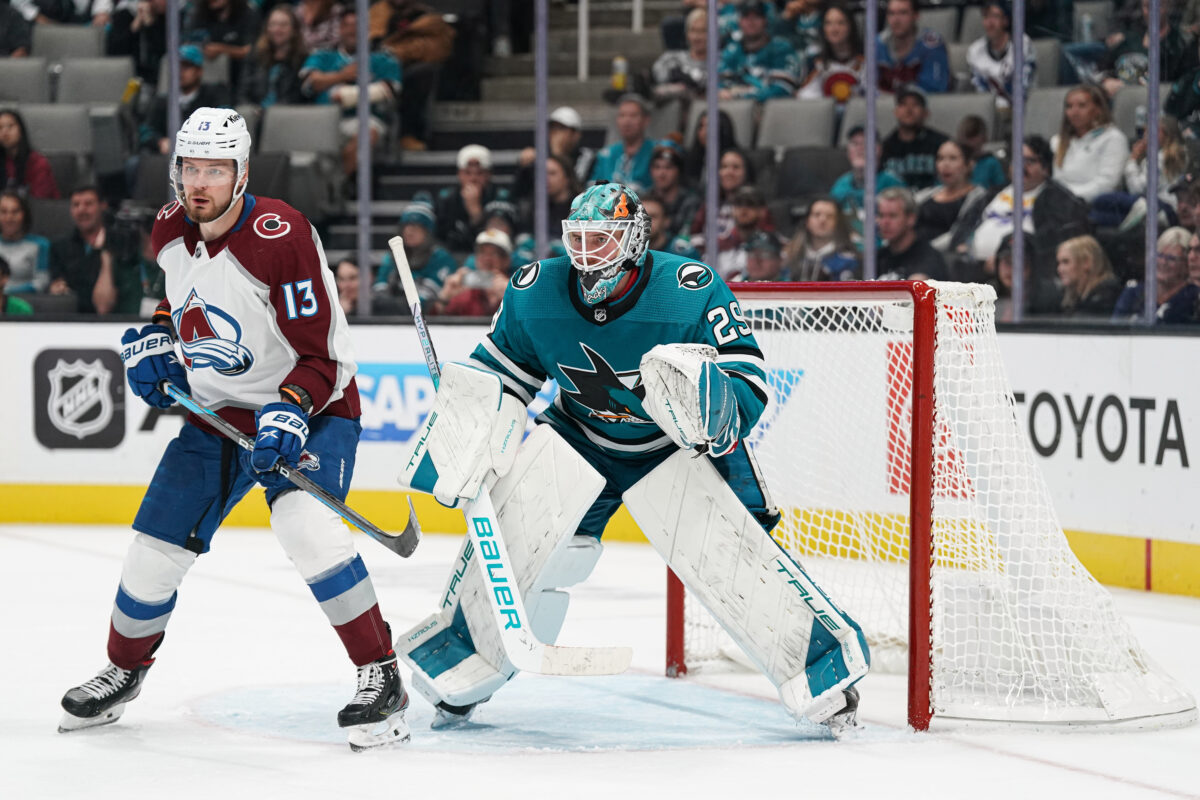
Blackwood is 6-17-3, and has minus-8.7 GSAA (which cuts off the argument that his defense is making him look bad). Sure, you can chalk up the league-worst 3.69 GAA to the team he plays for, but the .894 SV% is harder to justify. Blackwood’s best accomplishment is probably his .556 QS%, which means he is at least keeping the Sharks in more games than not. But there’s still a reason he was cast away by the Devils and marooned with the Sharks. He has not delivered on the promise he once had as a young netminder.
29) John Gibson: Anaheim Ducks
Previous Rank: 25
John Gibson is evidence of what years of bad defending can do to a goaltender. He was once one of the league’s top netminders, but now, he’s a shell of his former self. It’s no surprise, though, as the Anaheim Ducks feel stuck in a perpetual rebuild. Gibson features in trade discussions routinely, but his play has not tempted anyone to take on the remaining three and a half seasons on his contract at a $6.4 million average annual value (AAV). He is leading the league in losses for the fourth season in the last five, so, in a sense, the Ducks are getting their money’s worth out of him. As long as he’s on their team, they will ride him until there’s nothing left.
28) Filip Gustavsson: Minnesota Wild
Previous Rank: 10
Entering the season, there were big questions about Filip Gustavsson. He had put up some of the most ridiculous goalie numbers in recent memory and yet hadn’t quite convinced the Minnesota Wild to make him the undisputed starter entering the playoffs over Marc-Andre Fleury. But with Fleury’s career winding down, Gustavsson was the presumptive starter entering the season. Could he continue the outrageous success he’d seen in his first season in the Twin Cities?
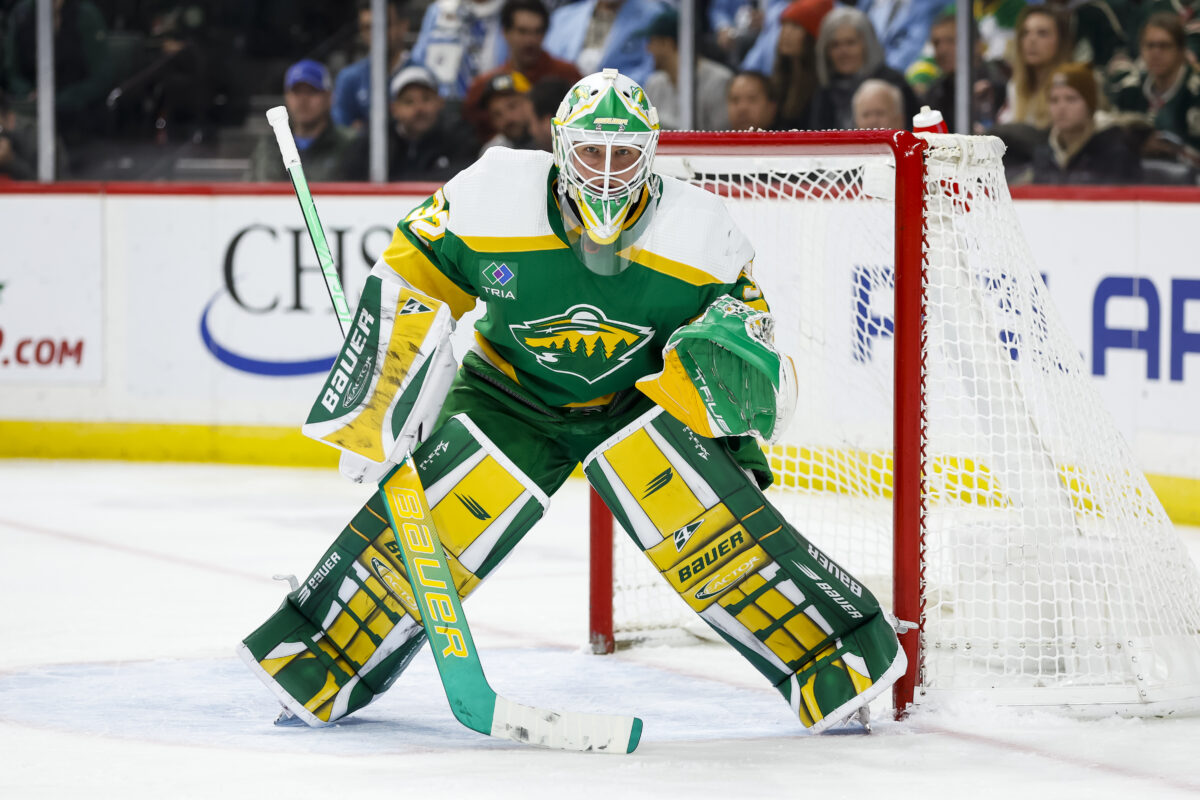
No. Gustavsson has come up severely short this season, which has helped contribute to the Wild’s disastrous season. He is 11-11-2 with an .892 SV% and a 3.36 GAA. He has minus-7.8 GSAA and a .375 QS%. His stats are bad. But Fleury’s aren’t much better. In fact, the Wild recently gave 21-year-old prospect Jesper Wallstedt his NHL debut, perhaps in part hoping they might find a solution for their goaltending woes. The Wild bet on Gustavsson with a three-year contract extension before the season. Right now, they might be regretting that bet. And given his relative lack of NHL experience, he drops near the bottom of this ranking.
27) Alexandar Georgiev: Colorado Avalanche
Previous Rank: 8
The Colorado Avalanche have eschewed the old adage that champions are built from the net out. After winning the Stanley Cup, they allowed Darcy Kuemper to leave for the Washington Capitals (a good decision) and brought in Alexandar Georgiev. The first season of the Georgiev era was a huge success for the Bulgarian, but season two has raised some major red flags. Though he does lead the league in wins at 25, that says more about the mighty team around him than it does about his play. He’s got a .895 SV%, a 2.98 GAA, and .421 QS%, along with minus-8.6 GSAA. It doesn’t seem to be phasing the Avalanche, though. Georgiev currently leads the NHL in games played and minutes. But he also leads in goals against, which has him near the bottom of this list.
26) Darcy Kuemper: Washington Capitals
Previous Rank: 9
The Avalanche might be regretting their decision to let Kuemper leave for Washington, but he isn’t doing any better in the District. The Capitals’ one purpose as a franchise right now is getting Alex Ovechkin the career goals record, so maybe Kuemper’s numbers aren’t that big a deal. But he possesses a .895 SV%, a 3.13 GAA, and minus-5.8 GSAA. He’s a Stanley Cup winner, and he earned his five-year, $26.25 million contract. But right now, he isn’t playing up to that level with Washington.
25) Elvis Merzlikins: Columbus Blue Jackets
Previous Rank: 32
Elvis Merzlikins has not covered himself in glory in recent seasons, but the 2023-24 season has been something of a bounce-back campaign for him, if not for the Columbus Blue Jackets. He has a .905 SV%, 3.26 GAA behind a bad defense, and 1.3 GSAA. The Blue Jackets have seemingly been trying to find Merzlikins’ replacement this season, trying Spencer Martin, Daniil Tarasov, and Jet Greaves out at different points. The fact that Merzlikins has outperformed them all this season has not kept the Blue Jackets from trying alternatives. In fact, he recently went over two weeks without starting, prompting him to request a trade out of Columbus. It’s tough to know if any team will be willing to take a chance on him given his contract, but his days as a Blue Jacket might be numbered either way.
24) Sam Montembeault: Montreal Canadiens
Previous Rank: Unranked
The Montreal Canadiens franchise has had some of the greatest goaltenders in NHL history. Sam Montembeault probably won’t join that list of legends that includes Ken Dryden, Jacques Plante, new New York Islanders head coach Patrick Roy, and Carey Price, but he has played well enough to earn the starter’s net more often than not this season.
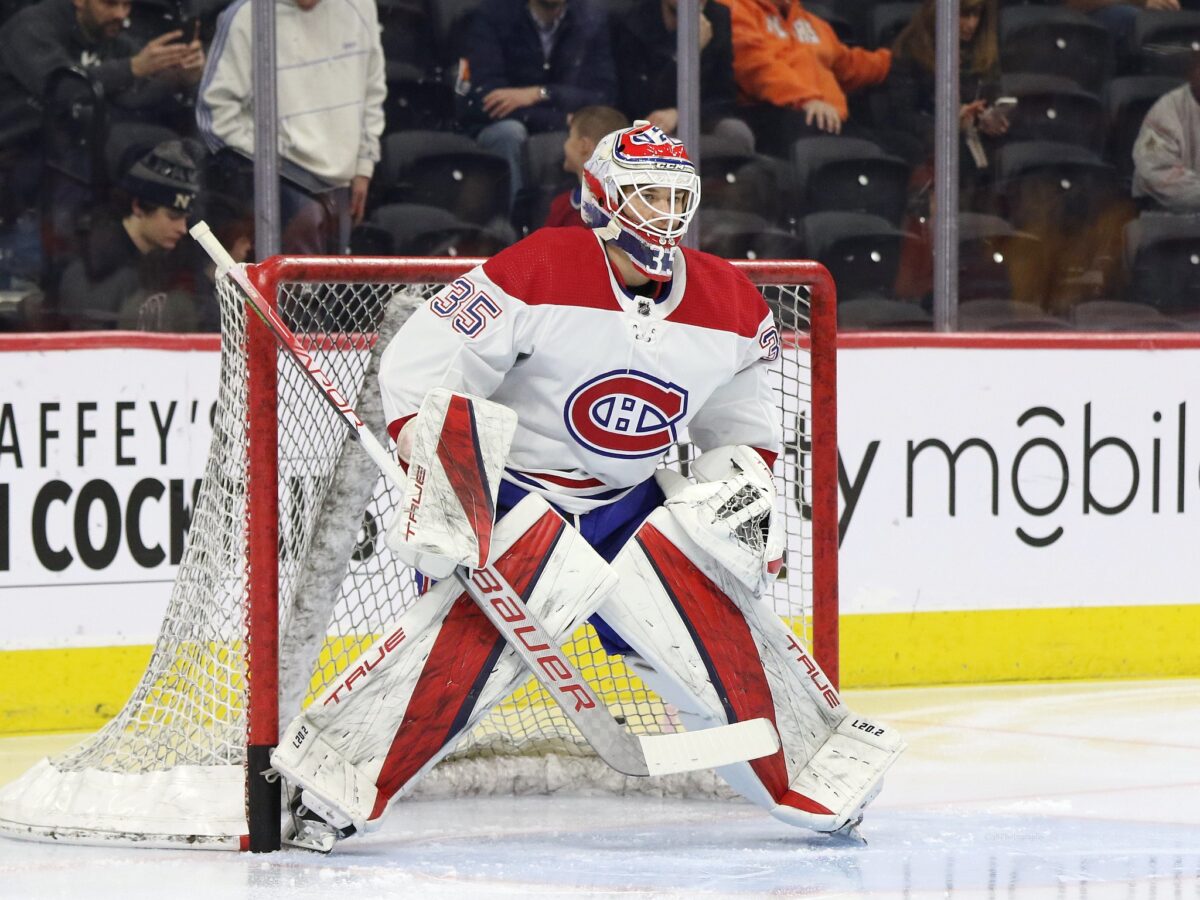
Montembeault has a .903 SV%, a 3.11 GAA, and minus-0.4 GSAA. Those aren’t eye-popping numbers, but behind a lackluster Canadiens team, they are impressive. And his .714 QS% is superlative. He has only started 21 games, and clearly, Cayden Primeau is expected to be the future in Montreal. But Montembeault has been a good story for the Canadiens so far.
23) Pyotr Kochetkov: Carolina Hurricanes
Previous Rank: Unranked
The Carolina Hurricanes’ crease is a rotating door of late. Frederik Andersen can’t stay healthy, and Antti Raanta seems to be a perpetual backup. It’s hard to pick a clear “starter,” but Pyotr Kochetkov seems to have once again grabbed control of the role for now.
Related: Top 10 NHL Backup Goaltenders
Kochetkov has started 21 games this season and gone 11-7-3. He has a .900 SV% and 2.58 GAA, with minus-1.9 GSAA. His .571 QS% is slightly above league average. Everyone believes that the Hurricanes are a great team, but the franchise cannot seem to solve its goaltending problem. Kochetkov does not seem to be the solution, but he is the current experiment, and he’s doing ok.
22) Alex Lyon: Detroit Red Wings
Previous Rank: Unranked
What a 12-months it has been for Alex Lyon. A year ago, he was a journeyman third-string goaltender with 30 games played in the NHL. Suddenly, he found himself the Florida Panthers’ starting goaltender heading into the playoffs — until Sergei Bobrovsky took over and went on a run for the history books. But Lyon’s surge into the playoffs was enough to earn him a two-year contract from the Detroit Red Wings, where he was expected to back up Ville Husso. But his run of net-stealing form has continued.
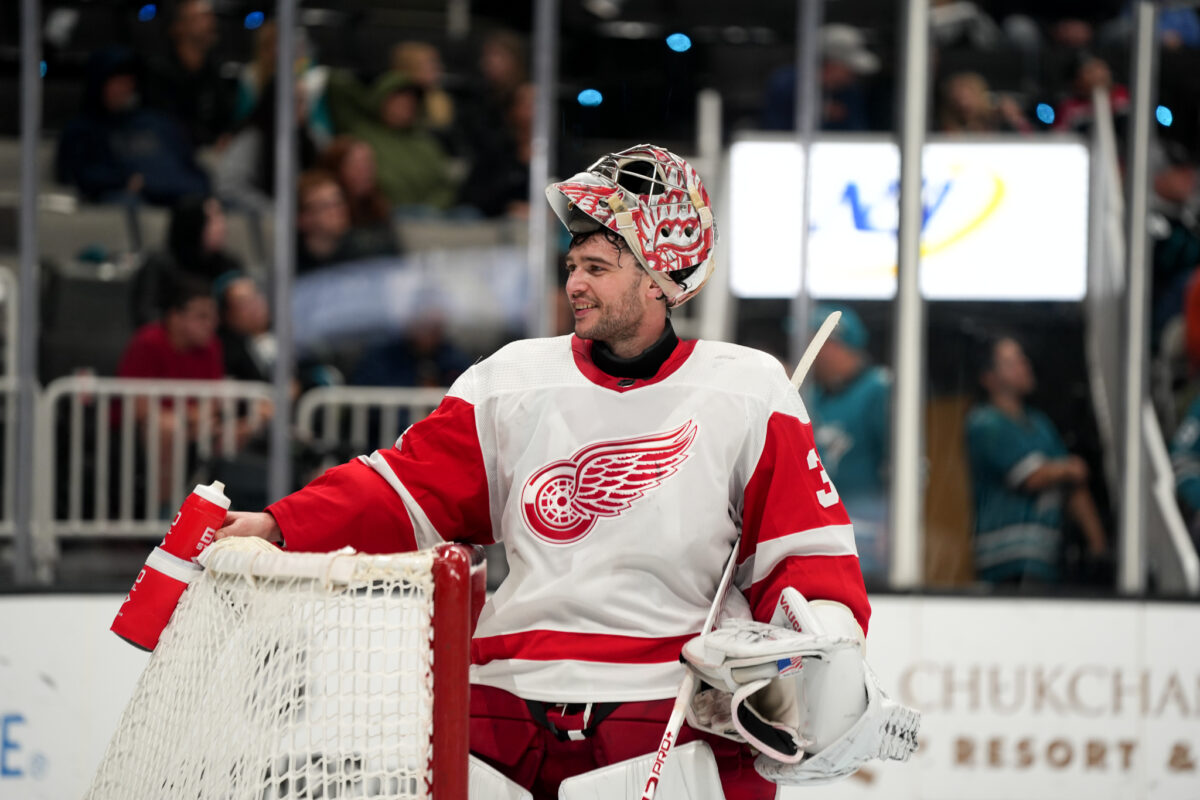
Though he has only started 16 games, Lyon seems to have a stranglehold on the net at this juncture, given how far he has outperformed his peers in Detroit. He has 9 GSAA, a .922 SV%, and a 2.57 GAA, all stats that could put him near the top of this list if he maintained them for a full season. Lyon has helped the Red Wings stay in third position in the Atlantic Division, exceeding expectations for the franchise entering the season. Whether he is a long-term answer in the Motor City remains to be seen, but Lyon might have made the biggest jump of any goaltender over the last 12 months.
21) Petr Mrázek: Chicago Blackhawks
Previous Rank: 30
The Chicago Blackhawks are the second-worst team in the NHL, but Connor Bedard and Petr Mrázek are the only reasons they aren’t even worse. There is no reason the 32-year-old Czech journeyman should be having as good a season as he is, but he’s having one of his best seasons ever in the Windy City. The numbers are impressive, given the context of the team he’s playing on: .906 SV%, 3.04 GAA, and 2.8 GSAA. With many goalies lower on this list, there will be those who say, “well, he looks worse because of his defense.” But Mrázek is doing all this despite one of the worst defenses in the league, and he deserves some recognition for that.
20) Ukko-Pekka Luukkonen: Buffalo Sabres
Previous Rank: 22
At the start of the season, we wrote: “No sooner had the [Ukko-Pekka] Luukkonen era finally begun than the hype about Devon Levi began in earnest. Now, he’s potentially moving into the starter’s role soon. It might be him on this list next time instead of Luukkonen.” But, to the Espoo, Finland native’s credit, he has held down the net and looked impressive this season.
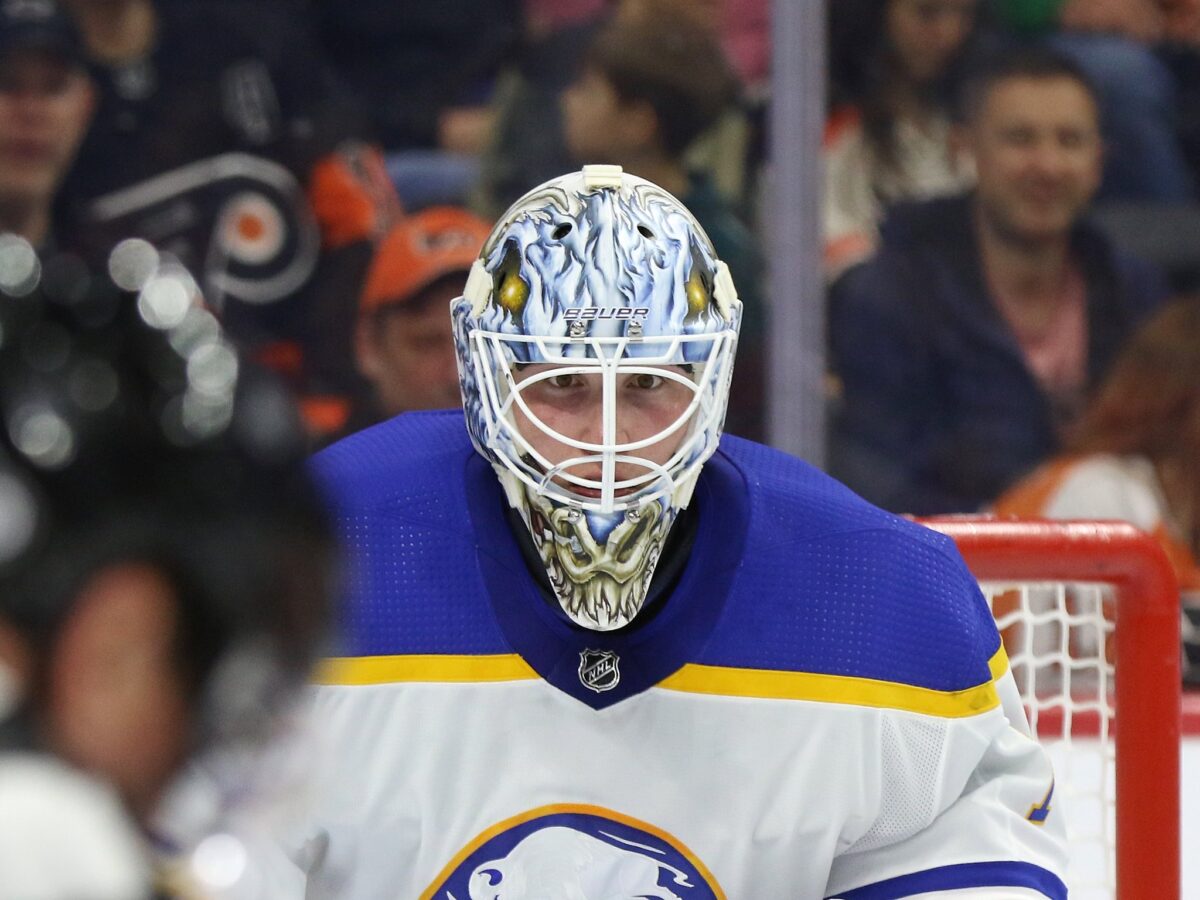
The soon-to-be 25-year-old has long been the Sabres’ goalie of the future. But his time in the Queen City has finally come, and he is delivering — despite the Sabres’ continued struggles overall. He has a .908 SV%, 2.61 GAA, and 2.8 GSAA. His .619 QS% is well above average. Though he’s just 11-10-2, he is performing as well as can be expected of him, and he hasn’t yet ceded the net to Levi.
19) Joseph Woll: Toronto Maple Leafs
Previous Rank: Unranked
Few people have heard of Dardenne Prarie, Missouri, the hometown of 2016 third-round draft pick Joseph Woll. But, then again, few had heard of Woll himself before he played well in four postseason games with the Toronto Maple Leafs last spring. But the then-24-year-old prospect rose to the challenge and proved himself a capable stopgap in the Leafs’ time of need, and justified the organization’s hopes in him as a goaltender of the future. Now, in the 2023-24 season, the Leafs have had plenty of goaltending controversy, with Ilya Samsonov being waived and Martin Jones playing well and getting plenty of starts. But Woll is the clear choice for Toronto’s number-one goaltender going forward, with his 6.3 GSAA and .916 SV%. Whether he’s officially the “starter” free and clear yet, he will be before long. And he’s had a great start to his NHL career.
18) Jordan Binnington: St. Louis Blues
Previous Rank: 31
Jordan Binnington etched his legacy in the NHL by hoisting the Stanley Cup at the end of his rookie season. But his path since then has been fraught with volatility. He has become too well-known for his on-ice antics. And in recent seasons, he’s been an extremely subpar goaltender. Coming into the 2023-24 season, with just rookie Joel Hofer backing him up, he had to answer the bell and prove that there was something of that Stanley Cup winner still buried deep inside.
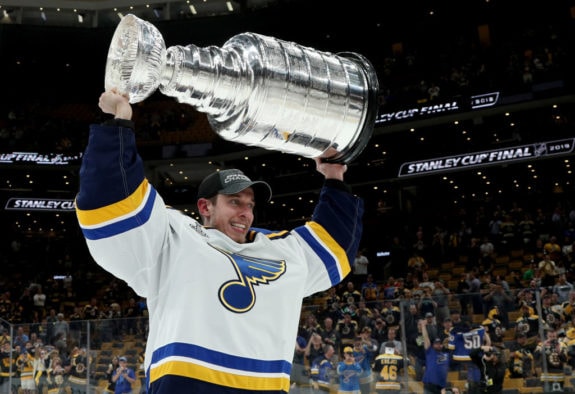
So far, he has proven the doubters wrong. Though the Blues are in the midst of their second extremely disappointing season, Binnington has been one of the few bright spots. It’s not that he’s been dominant like he was as a rookie. But on a very poor team with an incredibly unreliable defense, he has been above league average, with a .906 SV% and 2.6 GSAA. He’s righted the ship of very poor QS% from the past few seasons with a .533 mark this season. Binnington might not be on another Stanley Cup campaign, but he at least seems to be back to an NHL-caliber goalie, and that was a much needed boost for the Blues organization.
17) Stuart Skinner: Edmonton Oilers
Previous Rank: Unranked
When we posted the preseason update, we had Jack Campbell penciled in as the Oilers’ starter, but we wrote: “Campbell may have already lost his spot to Stuart Skinner, and come the midseason update, there’s a good chance it will be his job and performance that gets ranked.”
Well, not only did Skinner supplant Campbell, but the latter’s abysmal start saw him waived and sent to the American Hockey League (AHL). Skinner’s season didn’t exactly start gloriously, either, and there were even rumors about the Oilers looking for a trade for Binnington or another available goaltender. But Skinner has righted the ship in a big way and has helped the Oilers go on an incredible run of success. He now has a .906 SV%, a 2.53 GAA, 2.1 GSAA, and a .645 QS%, which is even more impressive considering his rancid start. At just 25, Skinner looks like the long-term answer in Edmonton, and he will continue to climb up this list if he plays this well.
16) Cam Talbot: Los Angeles Kings
Previous Rank: Unranked
It’s probably time that we start to recognize Cam Talbot as one of the more consistent goalies of the last decade or so. He’s rarely been dominant (though starting 140 games in just two seasons in Edmonton was certainly impressive) but he’s as reliable as any of the journeyman veteran options out there. This season, he’s doing it again, now with the Los Angeles Kings, his fourth team in five years.
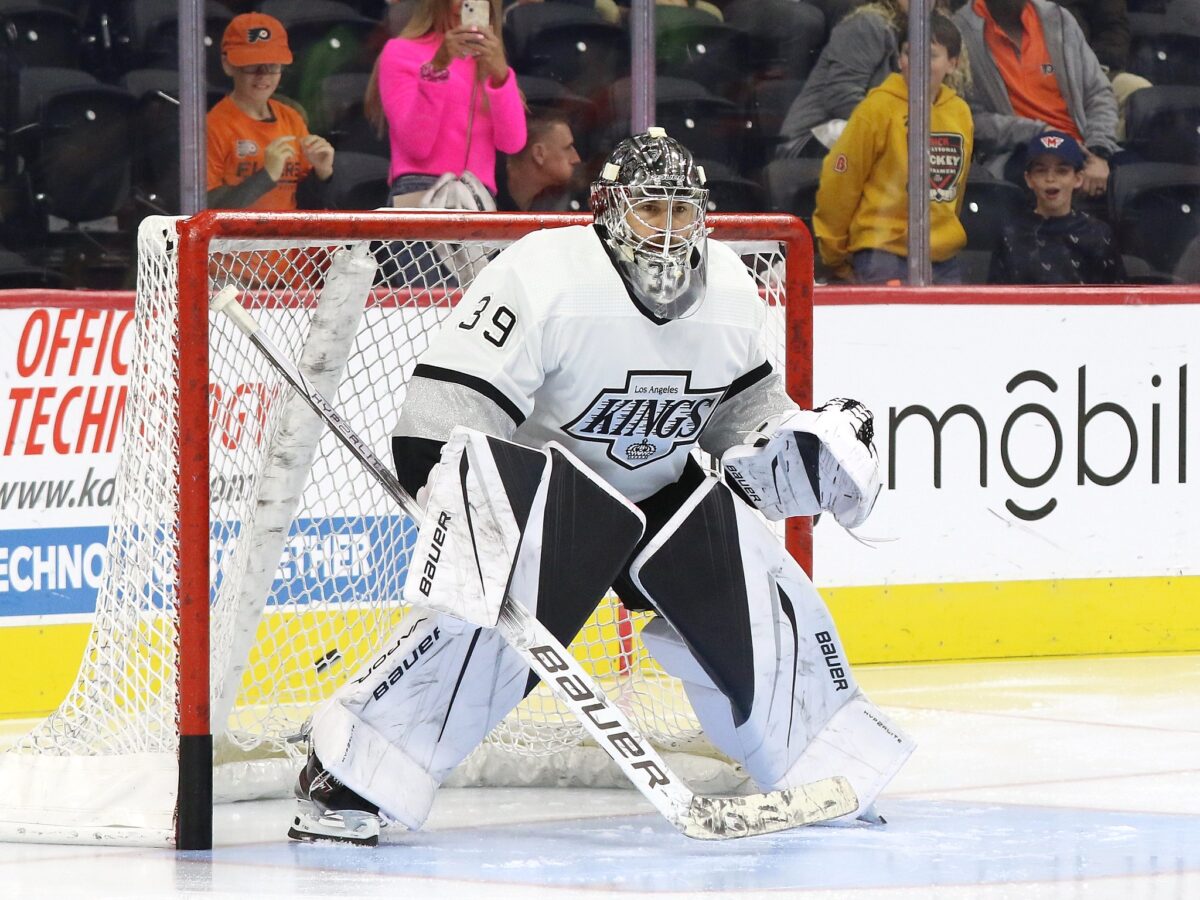
The Kings probably hoped to be in the Connor Hellebuyck sweepstakes before he re-signed with the Winnipeg Jets, but Talbot has been a pretty good consolation prize so far. He’s got a .915 SV%, a 2.43 GAA, .621 QS%, and 9.9 GSAA. He’s even got two shutouts on the young season. At 36, no one is really hoping to rely on Talbot for a long stretch, but you have to give it to him: he’s still out there doing his thing at a high level, and the Kings are thankful to have him.
15) Joey Daccord: Seattle Kraken
Previous Rank: Unranked
The Seattle Kraken didn’t expect Joey Daccord to be their starter this season, but he’s one of the best success stories so far in 2023-24. When Philipp Grubauer went down to injury unexpectedly, Daccord had to step up, and the way he’s been playing, it might not be Grubauer’s job anymore when the German gets back. Daccord has gone 13-8-8, helping the Kraken stay at least within tentacles’ distance of the playoff picture. And he’s had a .922 SV%, 2.33 GAA, and eye-popping 15.9 GSAA through 27 starts — some of the best goaltending in Kraken history. Daccord is just 27, and while Grubauer makes the big bucks in the Emerald City, they have the makings of a real goaltending controversy on their hands.
14) Jacob Markström: Calgary Flames
Previous Rank: 26
Jacob Markström at his best is still one of the best goalies in the world. He was runner-up for the Vezina Trophy just two seasons ago. Unfortunately for the Calgary Flames, they don’t see the best of Markström that much these days. He’s got a .909 SV%, a 2.69 GAA, 4.3 GSAA, and a .607 QS%. They’re solid numbers. But they’re far removed from the 26.1 GSAA and nine shutouts that he posted in the near-Vezina season. It’s a lot better than 2022-23. But Markström has a long way to go to firmly re-establish himself as an elite goaltender.
13) Connor Ingram: Arizona Coyotes
Previous Rank: Unranked
Hopes were high for Connor Ingram, a former third-round pick, at one point in his career. But the rise of Juuse Saros in Nashville made his road to the NHL infinitely harder, and it would take him a few years to reemerge with the Arizona Coyotes, which he did last season. He looked pretty good then, especially playing on a bad team. But in 2023-24, he has exploded and laid claim to the starter’s net full-time.
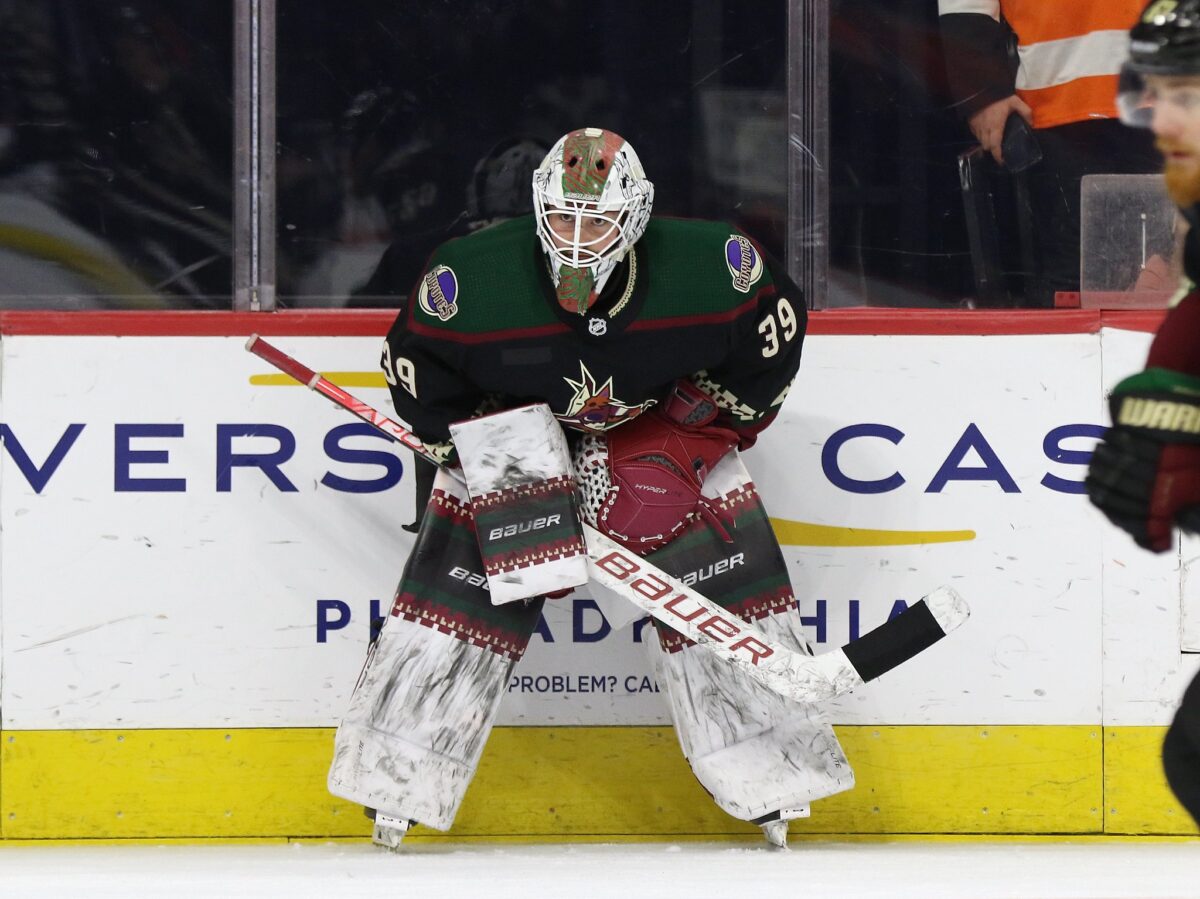
Through 30 games, Ingram’s numbers are elite: he’s 17-9-1, with a .919 SV%, 2.47 GAA, .679 QS%, and 13.5 GSAA. On top of that, he is tied for the league lead with five shutouts. It’s no wonder he has supplanted Karel Vejmelka. Ingram’s strong performance has the Coyotes unexpectedly fighting for a playoff spot as the All-Star Break approaches. Those kinds of elite numbers earned him a high spot on this list, but it’ll take a longer track record to earn him a spot in the top 10.
12) Carter Hart: Philadelphia Flyers
Previous Rank: 15
Speaking of teams that are unexpectedly fighting for a playoff spot, Carter Hart is one of the reasons the Philadelphia Flyers currently sit second in the Metropolitan Division. His .906 SV% and 2.80 GAA aren’t special, but he’s been a workhorse for Philadelphia in recent seasons, and his 2.1 GSAA is solid. But right now, his future is cloudy. As of this writing, news broke hours ago that the Flyers granted Hart an indefinite leave of absence for personal reasons.
11) Juuse Saros: Nashville Predators
Previous Rank: 5
If were ranking goaltenders just this season, Saros might be much lower down. He is 18-18-1, with a .904 SV%, 2.94 GAA, and 0 GSAA. But this isn’t a one-season ranking, although there is a strong recency bias. Saros has established himself as one of the best goaltenders in the league, and it will take a while for that reputation to ebb away. He still has a .918 career SV% to go along with 80.2 GSAA in 323 games played. So Saros has earned a little patience. Unfortunately, the Predators might not be able to give it to him. With just one season left on his contract after this one, and the Predators clearly in rebuilding mode, his name features heavily in trade rumors right now. Unfortunately for Nashville, his trade value has never been lower in recent seasons.
10) Igor Shesterkin: New York Rangers
Previous Rank: 7
Here’s another name whose reputation has boosted his standing. This season has been a bit of a mess for Igor Shesterkin, with minus-1.2 GSAA, a .902 SV%, and a 2.81 GAA. He looks like a shell of the goaltender who ran away with the Vezina Trophy back in the 2021-22 season.
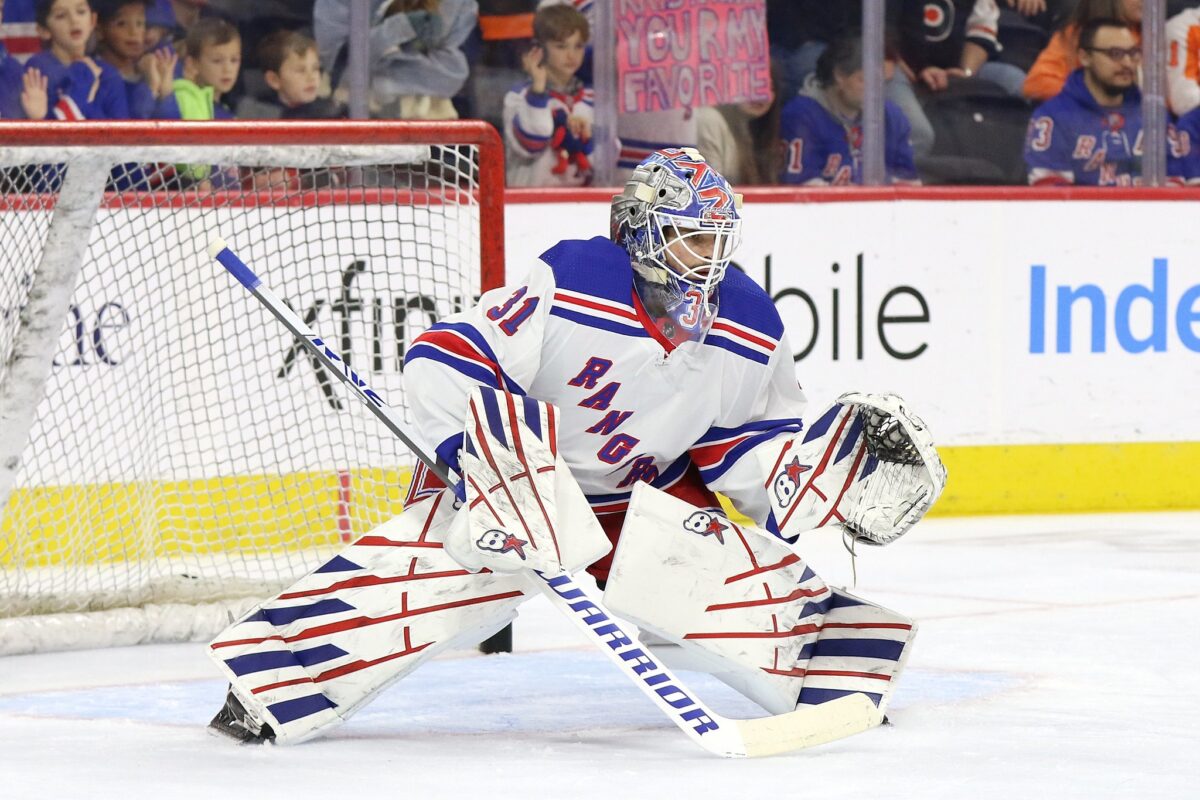
Shesterkin has struggled mightily this season. But it hasn’t kept the Rangers from establishing their place atop the Metropolitan Division. So the only question remaining to be answered is: will these struggles be permanent, or will the 28-year-old figure it out and return to greatness again?
9) Jake Oettinger: Dallas Stars
Previous Rank: Unranked
Now, to round out this trio of perceived top goaltenders who are underperforming this season, Jake Oettinger has not been his best this season. Look at the numbers: .904 SV%, 2.96 GAA, .458 QS%, 0.4 GSAA, and he’s just 13-9-2. In December, he suffered an injury that kept him out a few weeks, but Scott Wedgewood was not a better alternative in relief. The Stars are still in a playoff position, but as a team that expects to be top Cup contenders, they need better from Oettinger. At just 25, facing his first real adversity in the NHL, he has plenty of time to bounce back and reestablish himself before the playoffs.
8) Adin Hill: Vegas Golden Knights
Previous Rank: 12
At the start of the season, we ranked Adin Hill as the starter for the Vegas Golden Knights. How could you not? He had stepped into the breach and steered Vegas to its first Stanley Cup victory at the end of just their sixth season in the NHL. The Golden Knights even awarded Hill with a hefty contract extension that pays him nearly $10 million over two seasons. Now, halfway into the 2023-24 season, despite missing 15 games with an injury, it’s clear that he is not only the preferred starter in Vegas, he might be emerging as one of the best goalies in the league.
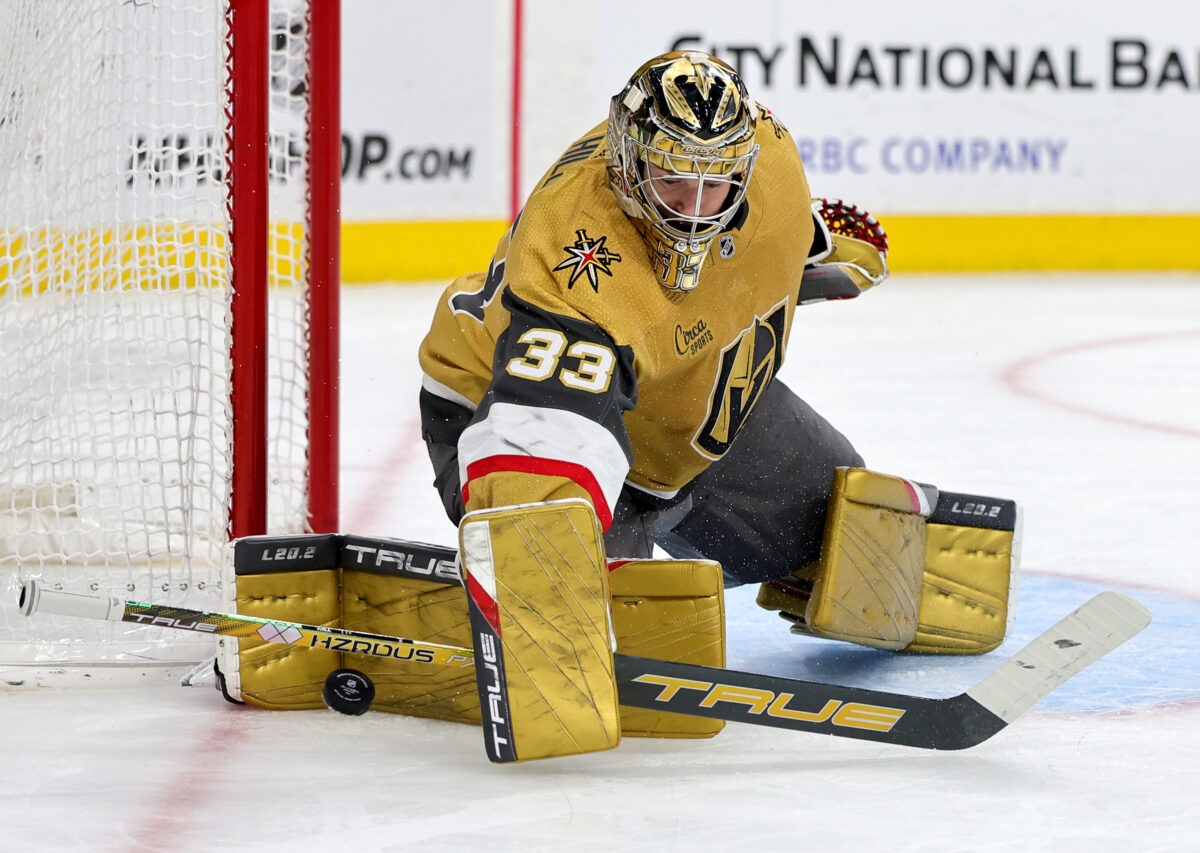
Hill has only started 17 games this season, but in that time he’s put up probably the best numbers in the league: .936 SV%, 1.94 GAA, .765 QS%, and a massive 15.9 GSAA. He’s gone 12-2-2 in 16 starts in that time. Those numbers are jaw-dropping, and the only reason Hill isn’t even higher in these rankings is the relatively strong sample size of his tenure. But if he continues to play like this, there’s no doubt he’ll move near or to the very top of the list.
7) Andrei Vasilevskiy: Tampa Bay Lightning
Previous Rank: 4
Andrei Vasilevskiy has earned the reputation as one of the best goalies in the world, and, quite frankly, is building a reputation as one of the greatest goaltenders of all time. But mileage and health are starting to become a concern. Entering the season, Vasilevskiy had surgery on his back that kept him out of action for the first two months of the season. Now that he’s back, he’s struggling to find his form. He’s got a .900 SV% and 2.85 GAA, with minus-2.5 GSAA. There’s not a lot of concern that Vasilevskiy will return to the upper echelon of goaltending again. With all he’s accomplished, he still won’t turn 30 until July after this season. He’s sure to go down in history as an all-time great goaltender. But he’s not quite at the top of his game right now.
6) Tristan Jarry: Pittsburgh Penguins
Previous Rank: 16
When it comes to Pittsburgh Penguins goaltenders, superstars like Marc-Andre Fleury and Tom Barrasso quickly come to mind. But it’s becoming time that Tristan Jarry joins that list. Quietly, he has become one of the more consistent goaltenders in the NHL, with five consecutive seasons of positive GSAA numbers (32.7 total in that time). His career .914 SV% and 2.64 GAA are also impressive in the current era.
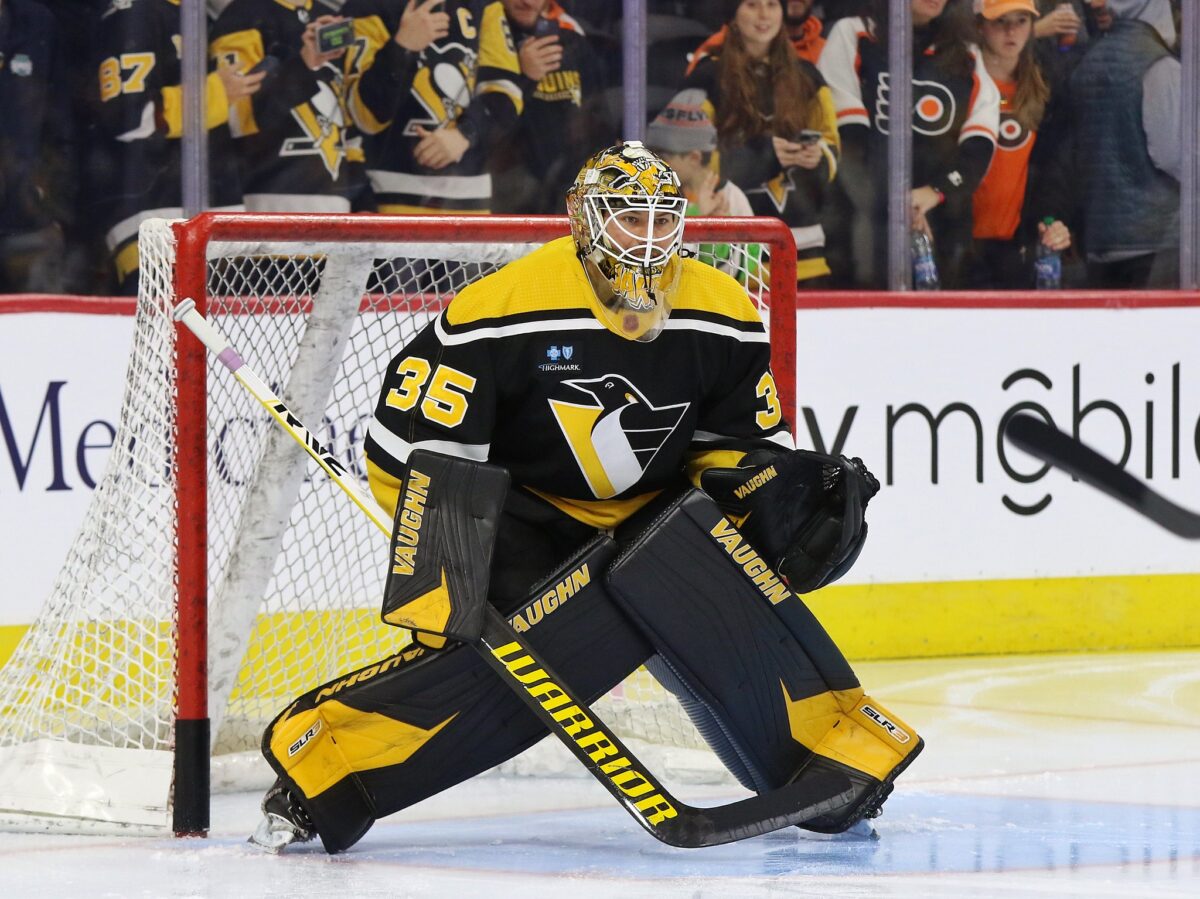
This season, Jarry’s numbers are in line with recent output, with a .913 SV% and 2.56 GAA. His 7.7 GSAA are strong, and he is tied for the league lead with five shutouts. Before the season, Jarry signed a five-year, $26.875 million contract extension to stay with the Penguins instead of going into free agency. At this point, it seems like a steal of a deal. Jarry has quietly become one of the league’s top goaltenders and probably isn’t discussed enough as one of the most consistent netminders in the NHL.
5) Linus Ullmark: Boston Bruins
Previous Rank: 2
It says a lot about the strength of the Boston Bruins’ goalkeeping tandem that Linus Ullmark is the reigning Vezina Trophy winner, and he’s not even clearly the starter in Boston as we write this. Since Ullmark and Jeremy Swayman have started roughly the same number of games, we’ll rank Ullmark as the starter now. But, quite frankly, either would rank in about this spot in our article.
Related: Bruins’ Ullmark & Swayman Both Have Vezina Potential in 2023-24
Ullmark, for his part, has certainly regressed from his Vezina Trophy numbers last season, but is still a very capable netminder. He’s got a .912 SV%, 2.82 GAA, and 5.9 GSAA. Especially noteworthy is his .682 QS$. He’s still a great goaltender, even if Swayman might be outperforming him slightly right now. One thing is certain: whichever of their two goalies the Bruins have in net on a given net, he’s sure to be one of the most reliable goaltenders in the league.
4) Sergei Bobrovsky: Florida Panthers
Previous Rank: 17
Sergei Bobrovsky’s entire career has been one of hot and cold, streaks on and streaks off. But since the postseason last year, he seems to be back on fire. Right now, he’s got a .910 SV% and 2.51 GAA with 6.7 GSAA. And after what he did in the postseason last year, with one of the most impressive runs in NHL history, it’s time to rank him among the league’s best again.
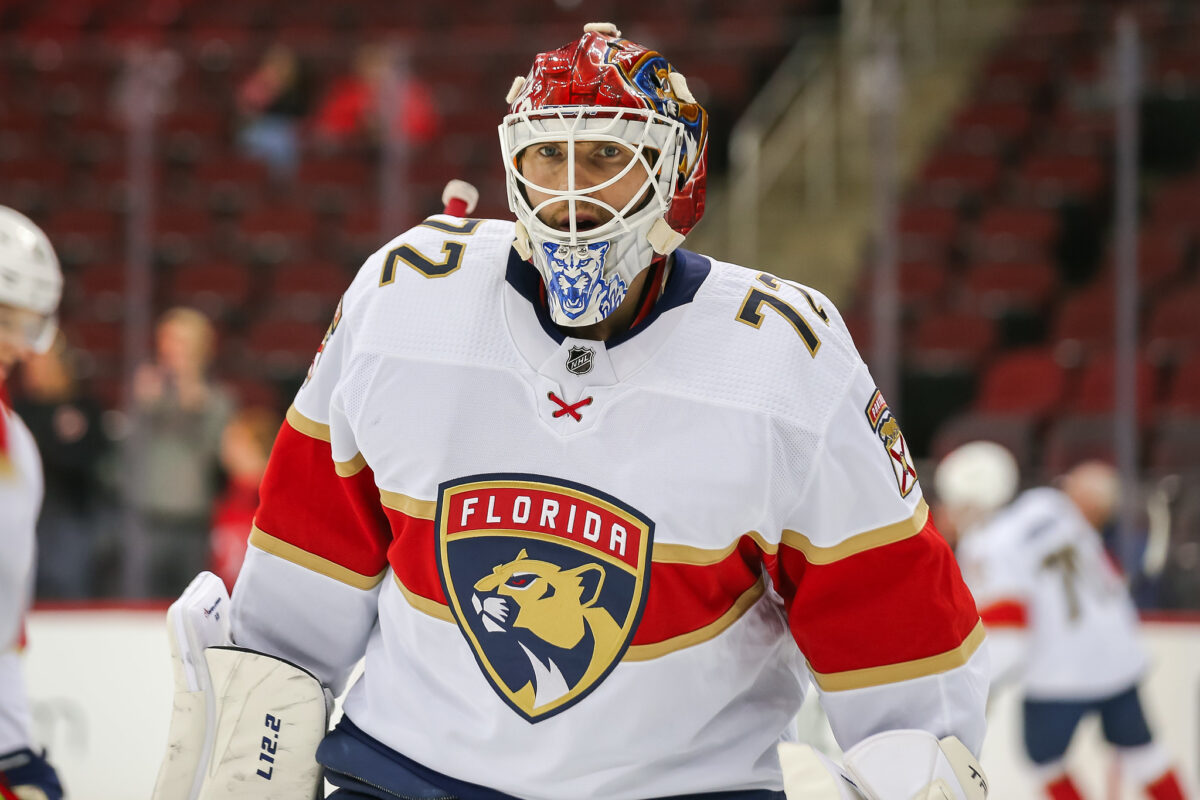
While Bobrovsky has become the focal point of a lot of criticism in recent seasons, owing to the massive seven-year, $70 million contract that he signed to move to Florida, it’s important to remember that there’s a good reason he was offered that kind of money. With as many great goalies as there are in the league right now, he was, and remains, the only active multiple-time Vezina Trophy winner in the NHL — winning the award in 2013 and 2017 — and one of just three goaltenders to win multiple since the 2004-05 lockout (with Martin Brodeur and Tim Thomas). There’s no question how good he can be at his best. And we saw it just last postseason.
3) Ilya Sorokin: New York Islanders
Previous Rank: 3
At 28, Ilya Sorokin is one of the most respected and feared goaltenders in the NHL. And while he hasn’t won a Vezina Trophy yet, he was a finalist last season, and might well be again this season. He is the only reason that the New York Islanders are even in the playoff conversation and now, with Roy coming on as his coach, who knows how dangerous he could become. He’s secured in his future, signing an eight-year, $66 million extension with the Islanders this summer. Right now, he has a .909 SV%, 3.17 GAA, .588 QS%, and 7.1 GSAA. But he’s faced the most shots in the league. He’s an extraordinary goaltender playing behind a pretty average team, and he’s making them stay relevant almost single-handedly.
2) Thatcher Demko: Vancouver Canucks
Previous Rank: 19
The jump from 19th to second might seem extreme at first, but there’s no question that Thatcher Demko always had this potential in him. And now that the team around him is playing like a contender, he finally gets to shine as the elite goaltender that he truly is. Demko has posted outrageous numbers this season, tying the league lead in shutouts with 5, while keeping a .922 SV%, 2.40 GAA, and 18.6 GSAA.
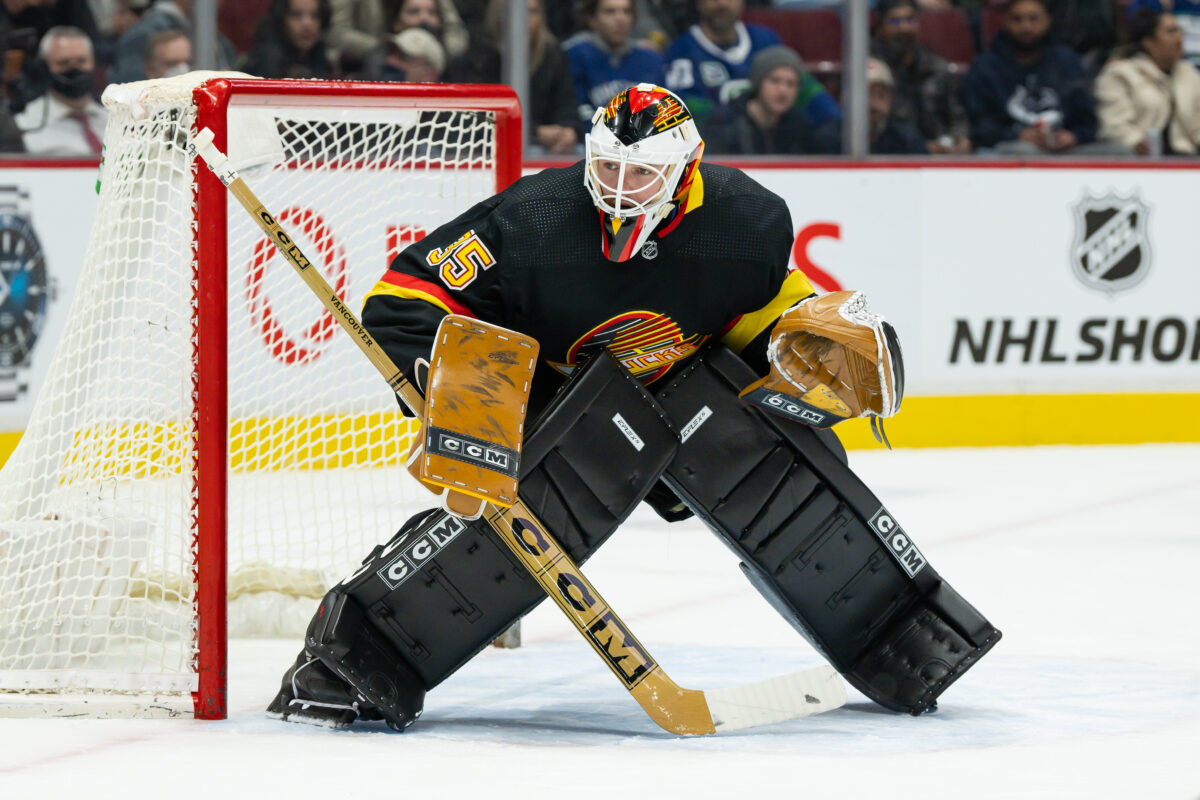
He also has a truly impressive .676 QS%, meaning he is keeping the Canucks in a huge majority of games. It certainly shows. While the whole team has played well, Demko is the leading reason why the Canucks are leading the Western Conference and currently tied for the Presidents’ Trophy lead with 69 points. His performance will earn him Vezina Trophy votes for sure (he’ll almost certainly be a finalist, and could eek out our number-one ranked goaltender for the honors), but like our top netminder, it should earn him some consideration for the Hart Trophy as well.
1) Connor Hellebuyck: Winnipeg Jets
Previous Rank: 1
Once upon a time, it seemed like this spot in the rankings would never belong to anyone other than Vasilevskiy. Now, the same can be said about Hellebuyck, who is by any metric the best and most valuable goaltender in the league right now. His .688 QS% and 31.3 GSAA were only enough to get him the third-place spot in Vezina Trophy voting last season, but he was not deterred. This season, he’s come back even stronger, and with a new contract.
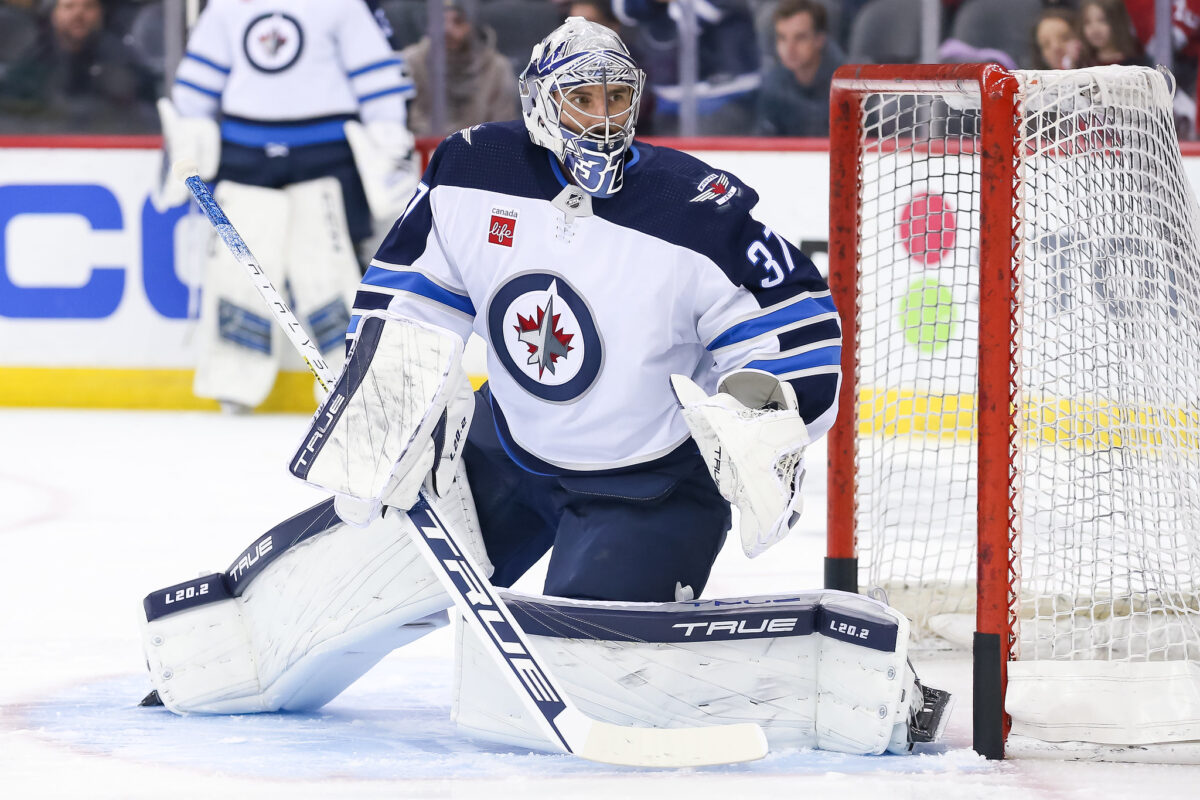
Though trade rumors swirled for what seemed like years about the Commerce, Michigan native, he kept a cool head and remained one of the most dangerous netminders in the NHL. And when push came to shove, he decided that he would stay put and spend presumably the rest of his career with the Winnipeg Jets, signing a seven-year, $8.5 million contract on the same day as Mark Scheifele back in October. Winnipeg has long had the reputation as a market players didn’t want to play in. but they were able to keep the top goaltender in the NHL for good, which could be a franchise-altering moment for them.
As for Hellebuyck’s play on the ice, it has hardly wavered. He has the Jets near the top of the Central Division with 65 points, thanks almost exclusively to his .925 SV%, 2.17 GAA, .706 SV%, and league-leading 21.4 GSAA. Hellebuyck might well join Bobrovsky as the only two-time Vezina Trophy winners in the league after this season. But he absolutely should be a top Hart Trophy contender, too. It seems like we’ll be waiting a long time to see another goaltender win the Hart Trophy (if we ever do — the last to do it was Carey Price in 2014-15) but Hellebuyck warrants strong consideration. He is the heart (no pun intended) and soul of the Jets and they would not be where they are today without him.
What Do You Think?
There are certain to be changes to this list before we re-rank after the season. Some goalies will lose their jobs, and others will have unexpected breakouts like Ullmark did last season. Who do you think will move up? Who do you think will plummet? And who do you think deserves to be higher right now? Let us know in the comments! Statistics can only measure so much. The impact of the true greats extends well beyond that. So who do you think is the best of the best? We can’t wait to hear from you.
